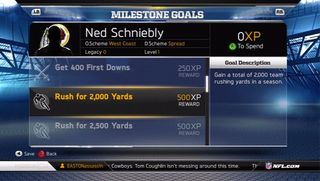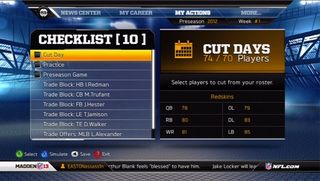Madden NFL 13 connected careers guide
Follow our advice, and you’ll be headed for the Hall of Fame in no time.

Season’s Start (Coach)
Now that you’ve officially begun your career as a head coach in the NFL, it’s time to start looking at the season ahead. Right off the bat, you’ll be given goals by the phantom ownership based solely on the team you’ve inherited. If you’re taking over the Colts, you’re goals for 2012 won’t be so lofty. However, if you’re the new playcaller for the Packers, post-season success is a must. There are also smaller game-to-game, and larger overall career goals to meet, but they won’t cost you your job if you don’t complete them.
Goals
Under the My Career tab, you’ll find a listing of you goals, your Legacy score, and how much experience you’ve earned to this point. By selecting the goals tab, you can view your season goals, weekly goals, milestone goals, and how much experience you’ll be rewarded with upon accomplishing each one.

Every year you’ll be given four season goals. You won’t get the experience from accomplishing those goals until after the Super Bowl is played, regardless of your making it to the title game or not. The goals are laid out by how easy they are to complete, with the level four goal being considered a healthy challenge. Based on your performace, these goals will change year to year. For example, your level four goal in the first year as the Colts head coach is to win eight games. If you happen to make it into the playoffs, in 2013, your level four goal will be to return to the post-season.
To keep a hold of your job, you must at complete at least the level two goal. Failure to meet even that standard could (and most likely will) result in your release from the team. Meeting your level two goal or above will result in getting a contract extension from the team. All of your contracts will be for one season, so you are constantly in jeopardy of losing your job in the off-season. Unlike the real NFL, you will never lose the job mid-season. In the event of your firing, you can choose to hope another team sees your potential and hires you, or you can create/take over another position by retiring your current coach.

Though you can only earn your season goal experience once a year, you can obtain experience from the game-to-game goals and milestone goals multiple times in a season.
The game goals are fairly simple to earn, and are a great way to obtain experience quickly and efficiently. You’ll only have a few goals to meet, and they don’t change during a given year. These goals are mostly tied to the team’s performance, and task you with getting multiple sacks, passing/rushing touchdowns, or meeting certain yardage requirements. The game goals don’t appear to offer much in the way of experience at first glance, but when you can earn say 300 XP for every game you net three sacks, the points rack up over the course of 16-20 games.

Milestone goals are a little more difficult to meet. These goals are cumulative over the course of a season and career, and again, you can meet some multiple times in a season. Goals like forcing multiple turnovers in a game or season, or tallying a specific amount of rushing yards during the year reward you for being proficient. Lengthier goals like winning multiple playoff games or getting multiple players nominated for the Pro Bowl reward you for putting together strong rosters. These goals will be the same no matter what type of coach you are, or what team you’ve taken over.

Weekly Activities
Once you’ve gotten a grasp of what you can and need to accomplish during the year, it’s time to get the ball rolling on playing games. Every week, you’ll have a list of activities to complete that not only impact your team immediately, but in the long run as well. All of your weekly activities can be viewed under the My Actions tab on the menu.

Cutting Players
You begin your first week on the job in the 2012 pre-season. Your roster will have close to 75 players on it, and you’ll need to cut that down to 53 by the fourth week. It’s not terribly difficult to do, as many of the additional players are just filler. They have terrible ratings compared to most of the pros you’ll go into the season with, though you do have full autonomy to cut whoever you want. It doesn’t make a whole lot of sense to cut your 95-rated defensive end, but if you really feel like it’s in the best interests of your team, there’s no reason you can’t.
Oddly enough, you’ll really only have to do this during your first season. Once you progress beyond 2012, your roster will pretty much be set at 53 players. You can pick up a bunch of undrafted or cut players from the free agent pool to see if you can find any gems, but the 2012 season is the only year in which it is mandatory to cut down the roster.
Practice
In previous Maddens, you could practice with your team all you wanted, but it didn’t really have any benefits. In Madden NFL 13, practicing every week gives you the opportunity to earn experience. There are multiple scenarios the game gives you the option of trying out, each with varying degrees of difficulty and rewards. Some of the practice options aren’t really worth the effort for the payout (full game for 1000XP), but the smaller challenges (like the two-minute drill) are a good way to gain additional experience points quickly.
You don’t have to practice if you don’t feel like the reward isn’t worth it, though even if you lose the challenge, you are still given a smaller amount of bonus experience.
Personnel Queries
From time to time, you’ll notice some personnel prompts appear in the weekly menu. These can range from other teams putting players on the trading block, to your own players wanting to negotiate new contracts before the season ends.
If a player has been put on the trading block, he will be much easier to obtain than a player a team hasn’t offered up to the league. It’s also worth noting that any time a trade offer appears, you get first crack (unless you’re playing in a season with multiple user teams) before the rest of the computer-controlled teams gets a shot. You can also add your own players to the trading block, and any offers you receive will appear in this same window.
Negotiating contract extensions with players during the season can be a bit challenging, but if a player requests an extension, that likely means he wants to stay on the team. That doesn’t mean you should immediately offer him less money than he’s asking for, but it does mean he’s willing to listen to a fair offer. If you’re close to a deal, but still a little off, the player will continue negotiations with you for a few weeks, or until a deal can be reached. You can choose to break off negotiations at any point, but keep in mind, you won’t be able to work out a deal with that player until free agency begins in the off-season.
Scouting
Every week of the regular season, you’ll earn scouting points to use on college players. In Connected Careers, scouting is incredibly important, and can’t be ignored like it was in previous Maddens. If you don’t scout out players ahead of the draft, you will not learn a single thing about them, which is very detrimental to not just your career, but also the success of the team.
The most important thing to do when scouting is to first find out if a particular player fits in with your offensive or defensive scheme. Drafting a player who isn’t suited to your coaching style won’t help, and you they won’t progress as quickly as someone who fits into your system. It’s one of the cheaper options to scout, and there is only one level, unlike the main attributes, which have two tiers of scouting each: a letter grade, and then the actual number. The letter grades are accurate, and to conserve scouting points, you should rarely ever scout an attribute a second time.
Also, you should spread out your scouting throughout the projected picks. There’s no reason to spend all your time scouting only players in the first and second round, as it’s unlikely you’ll ever be able to get more than two such players. Finding depth and players who can contribute to your team in the later rounds will only help. Besides, you can continue to boost a player’s stats throughout a season as they earn experience.
Progressing Players
This is easily the best and most appreciated new feature in Connected Careers. Previously, Madden progressed players automatically during the off-season, and it was really a crapshoot as to how much better/worse a player would become. Even if you had record-setting stats in multiple categories, players would often only increase a few points between seasons. Now, you not only have complete control over player progression, but you can even decide just what stats to improve.
Player performance dictates how much experience they gain during a week. Though you can choose in the mode’s settings how often you want to progress your players, the option will continually appear in your to-do list as long as any single player has experience to spend. You can also choose for the game to level up your players automatically, but we recommend only doing that for bench players and veterans. With any rookies or developing players you have on your team, it’s absolutely crucial to manage what attributes they improve yourself.
Just as key is knowing which attributes to improve. With a rookie like Robert Griffin III or Justin Blackmon, increasing their awareness during a season will show marked improvement in their performance as the games progress. You’ll also want to take note of weaknesses in star players’ ratings. To use the Colts as an example again, the switch to the 3-4 defense this year means former defensive ends Dwight Freeney and Robert Mathis have moved to outside linebacker, and they aren’t suited for man or zone coverage. They’ve got great attributes in almost every other important category, but improving those trouble areas quickly can make all the difference late in the season.
It’s also worth mentioning that players will have their own goals to meet over the course of a season. A quarterback may have a certain number of touchdowns he needs to reach, while an offensive lineman will need to be part of a team that obtains a certain number of total rushing yards. Meeting these goals nets a given player a big experience bonus, and can go a long way in helping improve multiple attributes in large chunks. You can find out what each player hopes to do in the Team Goals section of Personnel menu under the More… tab.
Once you’ve finished off your weekly activities, it’s time to head to game day. After you finish up the regular season, a whole new batch of activities will spring up in the post-season.
Sign up to the GamesRadar+ Newsletter
Weekly digests, tales from the communities you love, and more

The cult vampire third-person shooter that nearly bankrupted the small studio that made it is getting a film adaptation from the Transformers producer

Fallout mod site says it's like players are downloading Skyrim "twice every second" after Amazon TV series drives fans back to the open-world RPGs

Almost every character to ever appear in X-Men comics is featured on this absolutely massive X-Men #700 variant cover